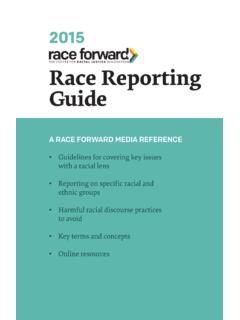Transcription of Racial Equity Impact Assessment - Race Forward
1 What are Racial Equity Impact Assessments? A Racial Equity Impact Assessment (REIA) is a systematic examination of how different Racial and ethnic groups will likely be affected by a proposed action or decision. REIAs are used to minimize unanticipated adverse consequences in a variety of contexts, including the analysis of proposed policies, institutional practices, programs, plans and budgetary decisions. The REIA can be a vital tool for preventing institutional racism and for identifying new options to remedy long-standing are they needed? REIAs are used to reduce, eliminate and prevent Racial discrimination and inequities. The persistence of deep Racial disparities and divisions across society is evidence of institutional racism the routine, often invisible and unintentional, production of inequitable social opportunities and outcomes. When Racial Equity is not consciously addressed, Racial inequality is often unconsciously should it be conducted?
2 REIAs are best conducted during the decision-making process, prior to enacting new proposals. They are used to inform decisions, much like environmental Impact statements, fiscal Impact reports and workplace risk are they in use? The use of REIAs in the is relatively new and still somewhat limited, but new interest and initiatives are on the rise. The United Kingdom has been using them with success for nearly a decade. EXAMPLES OF Racial JUSTICE Equity IMPACTSE quity and Social Justice Initiative King County, WA The county government is using an Equity Impact Review Tool to intentionally consider the promotion of Equity in the development and implementation of key policies, programs and funding and Social Justice Initiative Seattle, WA City Departments are using a set of Racial Equity Analysis questions as filters for policy development and budget Impact Statements Iowa and Connecticut Both states have passed legislation which requires the examination of the Racial and ethnic impacts of all new sentencing laws prior to passage.
3 Commissions have been created in Illinois and Wisconsin to consider adopting a similar review process. Related measures are being proposed in other states, based on a model developed by the Sentencing Racial Equity Impact Policy St. Paul, MN If approved by the city council, a Racial Equity Impact Policy would require city staff and developers to compile a Racial Equity Impact Report for all development projects that receive a public subsidy of $100,000 or Equality Impact Assessments United Kingdom Since 2000, all public authorities required to develop and publish race Equity plans must assess proposed policies using a Race Equality Impact Assessment , a systematic process for Equity Impact Assessment 2009, Terry Keleher, Applied Research Center. are sample questions to use to anticipate, assess and prevent potential adverse consequences of proposed actions on different Racial groups. 2009, Terry Keleher, Applied Research Center. CONSIDERING ADVERSE IMPACTS What adverse impacts or unintended consequences could result from this policy?
4 Which Racial /ethnic groups could be negatively affected? How could adverse impacts be prevented or minimized?7. ADVANCING EQUITABLE IMPACTS What positive impacts on equality and inclusion, if any, could result from this proposal? Which Racial /ethnic groups could benefit? Are there further ways to maximize equitable opportunities and impacts?8. EXAMINING ALTERNATIVES OR IMPROVEMENTS Are there better ways to reduce Racial disparities and advance Racial Equity ? What provisions could be changed or added to ensure positive impacts on Racial Equity and inclusion?9. ENSURING VIABILITY AND SUSTAINABILITY Is the proposal realistic, adequately funded, with mechanisms to ensure successful implementation and enforcement. Are there provisions to ensure ongoing data collection, public reporting, stakeholder participation and public accountability?10. IDENTIFYING SUCCESS INDICATORS What are the success indicators and progress benchmarks? How will impacts be documented and evaluated?
5 How will the level, diversity and quality of ongoing stakeholder engagement be assessed?1. IDENTIFYING STAKEHOLDERS Which Racial /ethnic groups may be most affected by and concerned with the issues related to this proposal?2. ENGAGING STAKEHOLDERS Have stakeholders from different Racial /ethnic groups especially those most adversely affected been informed, meaningfully involved and authentically represented in the development of this proposal? Who s missing and how can they be engaged?3. IDENTIFYING AND DOCUMENTING Racial INEQUITIES Which Racial /ethnic groups are currently most advantaged and most disadvantaged by the issues this proposal seeks to address? How are they affected differently? What quantitative and qualitative evidence of inequality exists? What evidence is missing or needed?4. EXAMINING THE CAUSES What factors may be producing and perpetuating Racial inequities associated with this issue? How did the inequities arise? Are they expanding or narrowing?
6 Does the proposal address root causes? If not, how could it?5. CLARIFYING THE PURPOSE What does the proposal seek to accomplish? Will it reduce disparities or discrimination? Racial Equity Impact Assessment GUIDE






